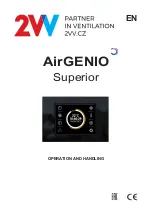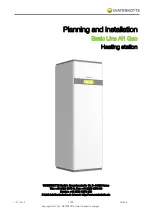
16
2.0 USE
2.1
RESCUE PLAN:
When using this equipment, the employer must have a rescue plan and the means at hand to implement it and
communicate that plan to users, authorized persons, and rescuers.
2.2
INSPECTION FREQUENCY:
Per the
Inspection Schedule (Table 2)
, SRDs must be inspected by a worker
1
before each use. SRDs must be
inspected by a Competent Person
2
at intervals determined from the Inspection Schedule. See the
Inspection and Maintenance Log (Table 3)
for inspections procedures.
Repairable SRDs must be submitted to a 3M Authorized Service Agent for Revalidation Inspection at intervals determined from the
Inspection Schedule (Table 2)
. The Authorized Service Agent will record their findings and label the product with the next annual service date.
Results of the Authorized Service Agent or Competent Person inspection should be recorded in the
“Inspection and Maintenance Log”
at the
back of these instructions or recorded with the Radio Frequency Identification (RFID) system (see
Section 5
).
2.3
NORMAL OPERATIONS:
Normal operation will allow the lifeline to extend and retract with no hesitation or slack as the worker moves at
normal speeds. If a fall occurs, a speed sensing brake system will activate, stopping the fall and absorbing much of the energy created.
Sudden or quick movements should be avoided during normal work operation, as this may cause the SRD to lock up. For falls which occur
near the end of the lifeline travel, a reserve lifeline system or Energy Absorber has been incorporated to reduce the fall arrest forces.
2.4
BODY SUPPORT:
A Full Body Harness must be used with the Self-Retracting Device. The harness connection point must be above the user’s
center of gravity. A body belt is not authorized for use with the Self-Retracting Device. If a fall occurs when using a body belt it may cause
unintentional release or physical trauma from improper body support.
2.5
COMPATIBILITY OF COMPONENTS:
Unless otherwise noted, 3M equipment is designed for use with 3M approved components and subsystems
only. Substitutions or replacements made with non approved components or subsystems may jeopardize compatibility of equipment and may
affect safety and reliability of the complete system.
2.6
COMPATIBILITY OF CONNECTORS:
Connectors are considered to be compatible with connecting elements when they have been
designed to work together in such a way that their sizes and shapes do not cause their gate mechanisms to inadvertently open regardless
of how they become oriented. Contact 3M if you have any questions about compatibility. Connectors (hooks, carabiners, and D-rings) must
be capable of supporting at least 5,000 lbs. (22.2 kN). Connectors must be compatible with the anchorage or other system components.
Do not use equipment that is not compatible. Non-compatible connectors may unintentionally disengage (see Figure 5). Connectors must
be compatible in size, shape, and strength. Self-locking snap hooks and carabiners are required. If the connecting element to which a snap
hook or carabiner attaches is undersized or irregular in shape, a situation could occur where the connecting element applies a force to the
gate of the snap hook or carabiner (A). This force may cause the gate to open (B), allowing the snap hook or carabiner to disengage from
the connecting point (C).
2.7
MAKING CONNECTIONS:
Snap hooks and carabiners used with this equipment must be self-locking. Ensure all connections are
compatible in size, shape and strength. Do not use equipment that is not compatible. Ensure all connectors are fully closed and locked. 3M
connectors (snap hooks and carabiners) are designed to be used only as specified in each product’s user’s instructions. See Figure 6 for
examples of inappropriate connections. Do not connect snap hooks and carabiners:
A. To a D-ring to which another connector is attached.
B. In a manner that would result in a load on the gate.
Large throat snap hooks should not be connected to standard size D-rings or similar
objects which will result in a load on the gate if the hook or D-ring twists or rotates, unless the snap hook is equipped with a 3,600 lb (16 kN) gate.
C. In a false engagement, where features that protrude from the snap hook or carabiner catch on the anchor, and without visual
confirmation seems to be fully engaged to the anchor point.
D. To each other.
E.
Directly to webbing or rope lanyard or tie-back (unless the manufacturer’s instructions for both the lanyard and connector specifically
allows such a connection).
F.
To any object which is shaped or dimensioned such that the snap hook or carabiner will not close and lock, or that roll-out could occur.
G. In a manner that does not allow the connector to align properly while under load.
Table 2 – Inspection Schedule
Frequency of
Use
1
Application
Conditions
Worker
Inspection
Frequency
2
Competent
Person Inspection
Frequency
3
Duration Between
Product Revalidation
Inspections
4
Infrequent to Light
Rescue, Confined
Space, Factory
Maintenance
Good Storage
Conditions, Indoor or
Infrequent Outdoor Use,
Room Temperature,
Clean Environments
Before Each Use
Annually
Not Longer than Every 5
Years
Moderate to Heavy
Transportation,
Residential
Construction, Utilities,
Warehouse
Fair Storage Conditions,
Indoor and Extended
Outdoor Use, All
Temperatures, Clean or
Dusty Environments
Before Each Use
Semi-Annually to
Annually
Not Longer than Every 2
Years
Severe to
Continuous
Commercial
Construction, Oil and
Gas, Mining, Foundry
Harsh Storage
Conditions, Prolonged
or Continuous Outdoor
Use, All Temperatures,
Dirty Environment
Before Each Use
Quarterly to Semi-
Annually
Not Longer than Every
Year
1.
Frequency of Use must be determined by a Competent Person
2.
Failure of a Worker to inspect “Before Each Use”, or failures identified during the Worker Inspection will require a Competent Person Inspection.
3.
Failure of a Competent Person to inspect per the frequencies in this Inspection Schedule, or failure identified during the Competent Person Inspection will require a
Product Revalidation Inspection or removal from service and disposal of the product.
4.
SRDs considered non-repairable, or not designed for disassembly and internal inspection do not qualify for Revalidation Inspection. These SRDs have other service
life and inspection requirements as provided in the manufacturer’s instructions.
1 Worker:
Any person who is protected from falling by an active and/or passive fall-protection system, or in the case of a fall-arrest system, any person who might fall
while attached to the system.
2 Competent Person:
An individual designated by the employer to be responsible for the immediate supervision, implementation, and monitoring of the employer’s
managed fall protection program who, through training and knowledge, is capable of identifying, evaluating, and addressing existing and potential fall hazards, and
who has the employer’s authority to take prompt corrective action with regard to such hazards
Summary of Contents for 3101257
Page 4: ...4 ...
Page 5: ...5 2 E D C A B G F C A B D H C A B B A C D h 3 A B FC FF DD SF FC FF DD SF C FC H ...
Page 7: ...7 7 B D C A 8 ...
Page 8: ...8 9 1 A B B A Delta III ExoFit NEX 2 C C D 3 4 5 A D A ...
Page 9: ...9 10 1 A B 2 C D D 3 F G E 4 A E 5 F E 6 A D C ...
Page 10: ...10 11 1 2 3 4 5 6 7 ...
Page 11: ...11 12 E D A G D B F C F 13 14 A B C 15 ...
Page 22: ...22 ...
















































